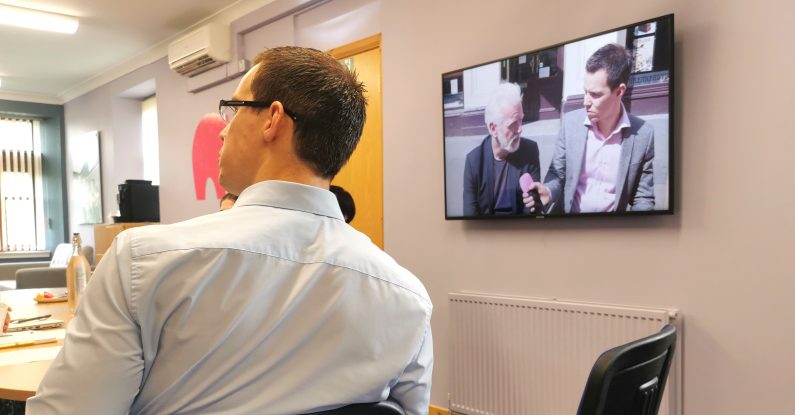
What will you learn on an assertiveness training course with Pink Elephant?
The first thing is that it’s ok to say no.
That prevents people from walking over you.
The second is that the long-term relationship is more important than the one-off transaction.
In summary, assertiveness can co-exist with politeness and respect.
Read on.
In a world without Google optimisation, I’d be tempted to rebrand our assertiveness training course.
I’d call them “saying no without offending people”.
The problem is: we dislike saying no.
As I’ve suggested on here before, those of us in customer-facing roles are taught:
“The answer’s yes. Now what’s the question?”
And within the organisation, we fear falling out with people.
In short, we aim to be liked rather than respected.
But let’s consider a lower-stakes scenario.
If you drove to our Glasgow studios at 8.30am and I asked you if you’d like a double whisky, you’d say no.
You may even follow up with “I’d love a coffee, though”.
That evening, if you visited a restaurant, you may be asked if you’d like a coffee, and reject that for something stronger.
We’re used to rejecting things that will do us damage and asking for things we want.
You can do the same in high-stakes scenarios.
“No”, when said in an upbeat tone and moving onto a different suggestion draws a clear line of expectation.
And it’s absolutely necessary to say.
“Can you get that to me tomorrow?”
An assertive reply is:
“No, I’m working on a major project that needs to be in tomorrow. How’s Friday?”
A second thing you’ll explore on an assertiveness training course is the importance of preserving the relationship.
Let’s deal with respect first of all.
In the scenario above, it’s tempting to say yes to your colleague to help them out.
But what happens when you’re unable to fulfil the brief?
The relationship suffers and you end up apologising for other things coming up.
You may have friends like this. Ones that say yes to everything and end up letting you down.
That’s why ‘no’ is a necessary step to preserving a long-term relationship.
Just like we set boundaries for our children using the word ‘no’, we can do the same with colleagues.
Of course, we also need to say yes when the request is achievable.
Next time, they’ll know they’ll get a straight answer from you and you’ll stick to your word.
What about if we’re the one giving the instruction?
In Britain, we can be very bad at giving clear, direct instructions.
I was on a train recently approaching Edinburgh Park station when a young, fresh-faced ticket attendant asked a woman (a non-English tourist, I suspect) if she could move her suitcase out the aisle.
The woman clearly struggled to understand the request.
This led to a back-and-forward that lasted a couple of minutes, with everyone in the carriage watching.
I sympathised.
The initial request sounded like this:
“Excuse me ma’am, I wondered if it was possible for you to maybe clear some space?
“It’s just we’ll have a lot of people moving through the carriage shortly and we don’t want anyone to trip over.
“Do you think that would be ok?”
Two minutes later, a frustrated passenger shuffled by the woman and offered:
“Move yer bag!”
There’s a lot to be said for directness under pressure.
Be specific, but polite.
“Excuse me, please move your bag. Thanks.”
Words like “I need you to” and “you must” have the same effect.
Direct, but clear.
The final, often unspoken part of being assertive, is the need to show empathy when the situation demands it.
We call it assertive empathy.
Consider the following situation:
“Hi there, can you all please be on the call 9am sharp tomorrow so we can start the meeting on time?”
And the response you get:
“I’ll certainly try, but I’ve got such a backlog of emails to work through that I might be 15 minutes late.”
At this point, you have three main options:
The assertive choice allows you to show empathy while also being firm on what’s expected.
An assertiveness training course can often fill people with dread.
Our goal on our sessions is to fill you with confidence.
We’ve done that for more than 30 years.
And we’ve shared our expertise with individuals all over the world.
We’ll work with you in advance to prepare realistic scenarios for you to put your skills to the test.
To see if you can leave a difficult conversation satisfied that you got what you wanted.
Photos in Assertiveness training course blog by Pink Elephant Communications.
Assertiveness training course blog edited by Colin Stone.
26th September 2022 Featured in: Assertiveness training blogs, Communication skills training blogs, Our courses blogs By: Pink Elephant
Some media trainers knock you down…and leave you down. Our media coaches show you how to deal with each knock…and still win through. So you have the presentation skills to perform – with confidence.